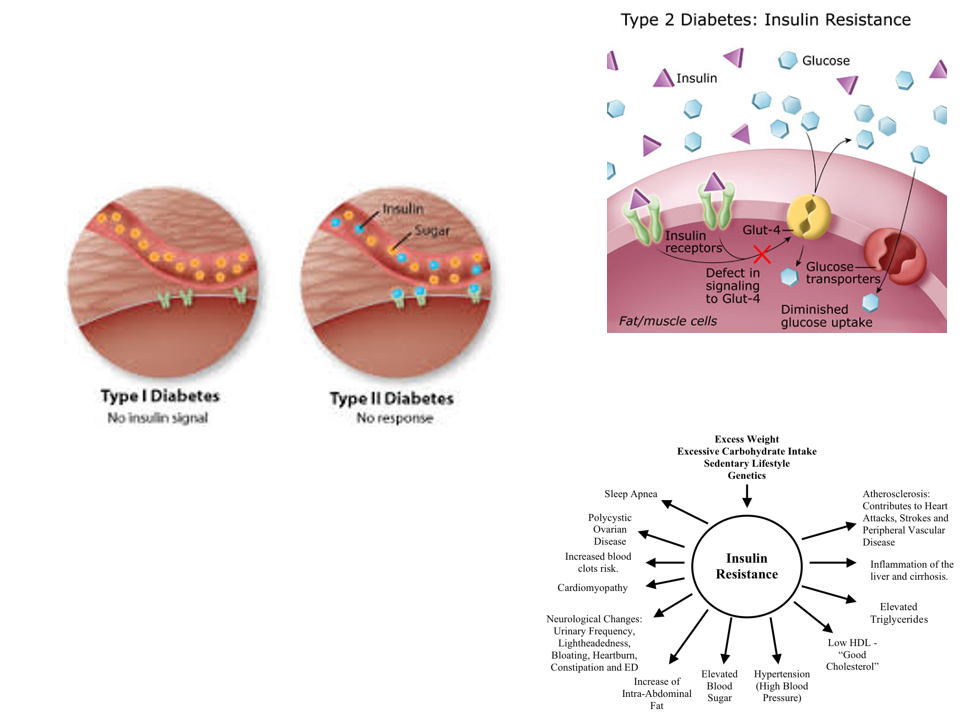A&P 2 Exam 1 - Endocrine Glands, Functions, Regulation
1/44
There's no tags or description
Looks like no tags are added yet.
Name | Mastery | Learn | Test | Matching | Spaced |
|---|
No study sessions yet.
45 Terms
Describe how the nervous system functions
Communicates through electrical impulses and neurotransmitters
Releases neurotransmitters at synapses at specific target cells
Effects are local, specific
Quickly responds to stimulus
Quickly stops response to stimulus
Quickly adapts to long-term stimulus
FAST
Describe how the endocrine system functions
Communicates through hormones
Release hormones into bloodstream for distribution throughout body
Effects are general, widespread
Slowly responds to stimulus
Slowly stops response to stimulus
Slowly adapts to long-term stimulus
SLOW
Describe the relationship between the nervous and endocrine system
Complementary function
Communicate chemically
Continually regulate each other
Releasing hormones (RH)
Gland: hypothalamus
Type: peptide, water-soluble, membrane receptors
Target tissues: anterior pituitary
Effects: cause secretion of specific hormones
Stimulus: hormonal (regulated by levels of downstream hormones)
Regulation: negative feedback from the hormones they ultimately stimulate (thyroid hormone inhibits TRH/TSH release)
Inhibiting hormones (IH)
Gland: hypothalamus
Type: peptides or amines, water-soluble, membrane receptors
Target tissues: anterior pituitary
Effects: inhibit secretion of specific hormones
Stimulus: hormonal/neuronal mix (regulated by circulating hormones or neural input like suckling)
Regulation: negative feedback (high GH → ↑ GHIH)
Antidiuretic hormone (ADH)
Gland: posterior pituitary
Type: peptide, water-soluble, membrane receptor
Target tissues: kidneys
Effects: increase water content (decrease osmolality), increase blood volume/blood pressure, reduce urine volume/concentration
Stimulus: humoral stimulus. high electrolytes (salt), low water, low blood pressure
Regulation: negative feedback (enough water = stop releasing ADH = neg. feedback)
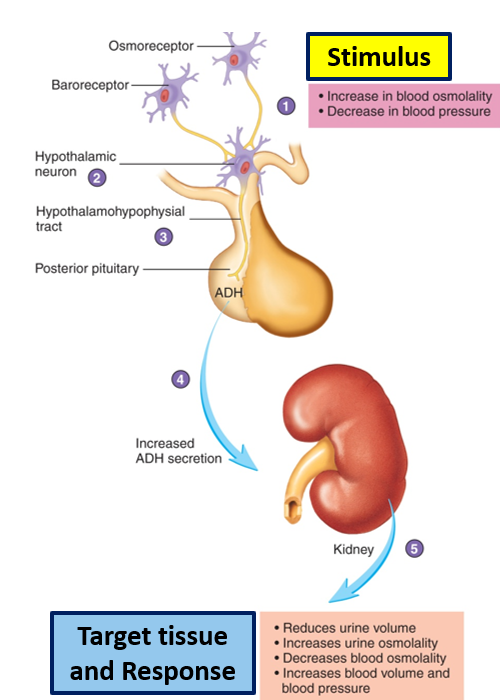
Oxytocin
Gland: posterior pituitary
Type: peptide, water-soluble, membrane receptors
Target tissues: uterus, mammary glands
Effects: uterine contractions, milk ejection ("let-down”)
Stimulus: neuronal stimulus. uterine stretch, suckling
Regulation: positive feedback until event ends (birth, feeding)
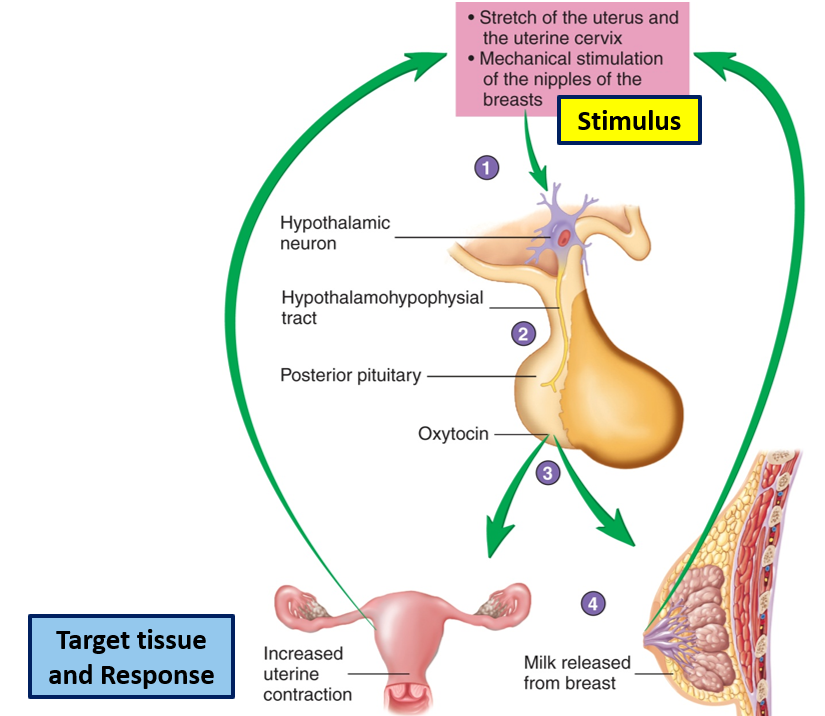
Thyroid-stimulating hormone (TSH)
Gland: anterior pituitary
Type: peptide, water-soluble, membrane receptor
Target tissues: thyroid gland
Effects: secretion of thyroid hormone
Stimulus: hormonal. thyroid RH
Regulation: negative feedback (TRH from hypothalamus → neg. fb from T3/T4)
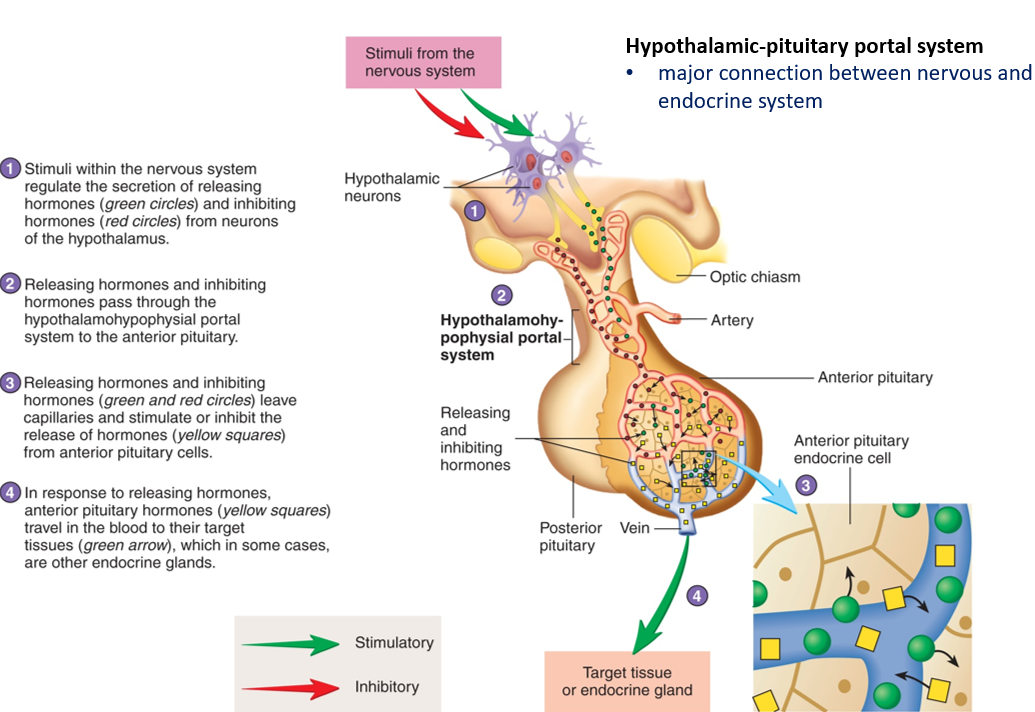
Growth hormone
Gland: anterior pituitary
Type: peptide, water-soluble, membrane receptor
Target tissues: all tissues
Effects: increase protein synthesis, increase fat breakdown, increase glycogen (glucose storage), increases tissue, bone and cartilage growth
Stimulus: hormonal. GH-RH, stress, low blood glucose, sleep
Regulation: negative feedback (GHRH → negative feedback from IGF-1)
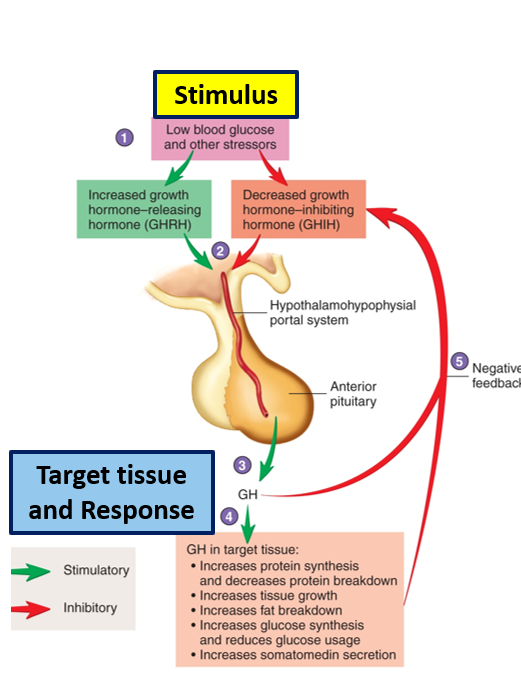
Prolactin
Gland: anterior pituitary
Type: peptide, water-soluble, membrane receptor
Target tissues: mammary glands
Effects: increase milk production
Stimulus: hormonal. prolactin-releasing hormone (PRH). inhibited by prolactin-inhibiting hormones (PIH)
Regulation: negative feedback when milk production not needed
Adrenocorticotropin hormone
Gland: anterior pituitary
Type: peptide, water-soluble, membrane receptor
Target tissues: adrenal cortex - zona fasciculata
Effects: secretion of glucocorticoids (cortisol)
Stimulus: hormonal. corticotropin RH
Regulation: negative feedback (CRH → negative feedback from cortisol)
Melatonin
Gland: pineal gland
Type: amine, water-soluble, membrane receptor
Target tissues: brain, eye, cardiovascular system
Effects: sleep/wake cycles (promotes sleep)
Stimulus: neuronal. decrease in light
Regulation: Neural input from retina (light/dark) → negative feedback
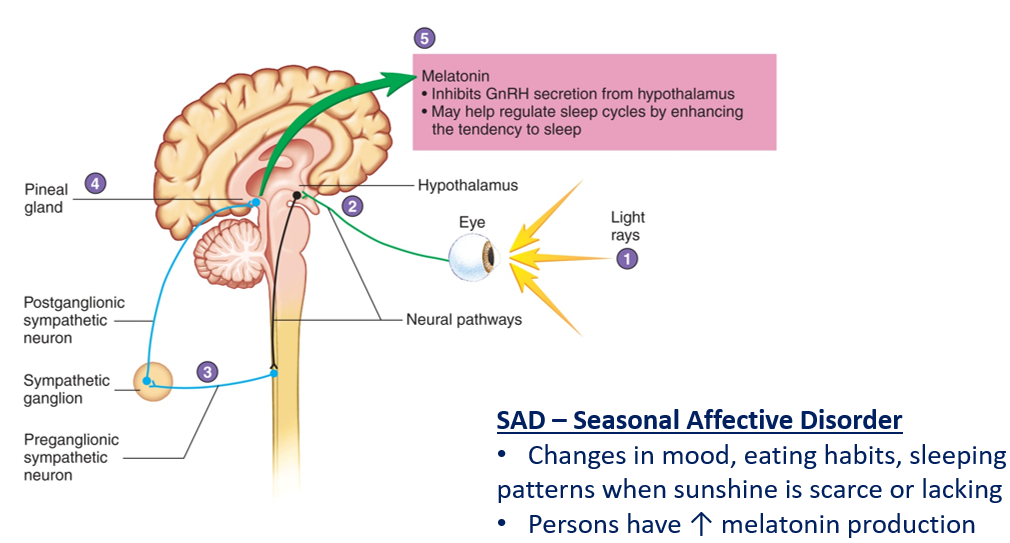
Thyroid hormone
Gland: thyroid gland - follicular cells
Type: amine, lipid-soluble, nuclear receptor
Target tissues: most cells
Effects: increases metabolism, increases body temperature
Stimulus: hormonal. TSH
Regulation: negative feedback by T3/T4 levels
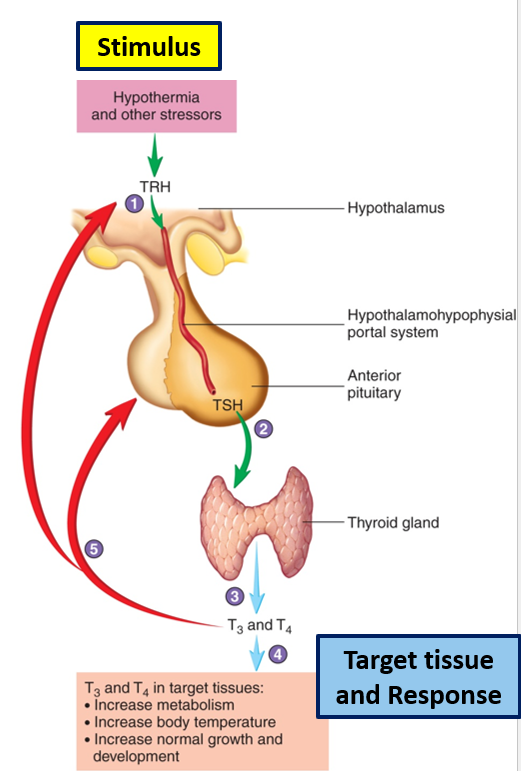
Calcitonin
Gland: thyroid gland - interstitial cells
Type: peptide, water-soluble, membrane receptor
Target tissues: bone
Effects: lowers blood calcium
Stimulus: humoral. high blood Ca2+
Regulation: negative feedback when blood calcium decreases
Parathyroid hormone
Gland: parathyroid gland
Type: peptide, water-soluble, membrane receptor
Target tissues: bone, kidney, intestine
Effects: increases blood calcium, vitamin D
Stimulus: humoral. low blood Ca2+
Regulation: negative feedback when blood calcium normalizes
Aldosterone (mineralocorticoids)
Gland: adrenal cortex - zona glomerulosa
Type: steroid, lipid-soluble, nuclear receptor
Target tissues: kidney
Effects: increases sodium reabsorption (reclaim sodium)
Stimulus: humoral. low salt, low water, low BP
Regulation: negative feedback when blood pressure & electrolyte levels normalize
Cortisol (glucocoritcoid)
Gland: adrenal cortex - zona fasciculata
Type: steroid, lipid-soluble, nuclear receptor
Target tissues: most cells
Effects: increases fat and protein breakdown, increases blood glucose, decreases inflammation
Stimulus: hormonal. ACTH, low blood glucose, stress
Regulation: negative feedback by cortisol
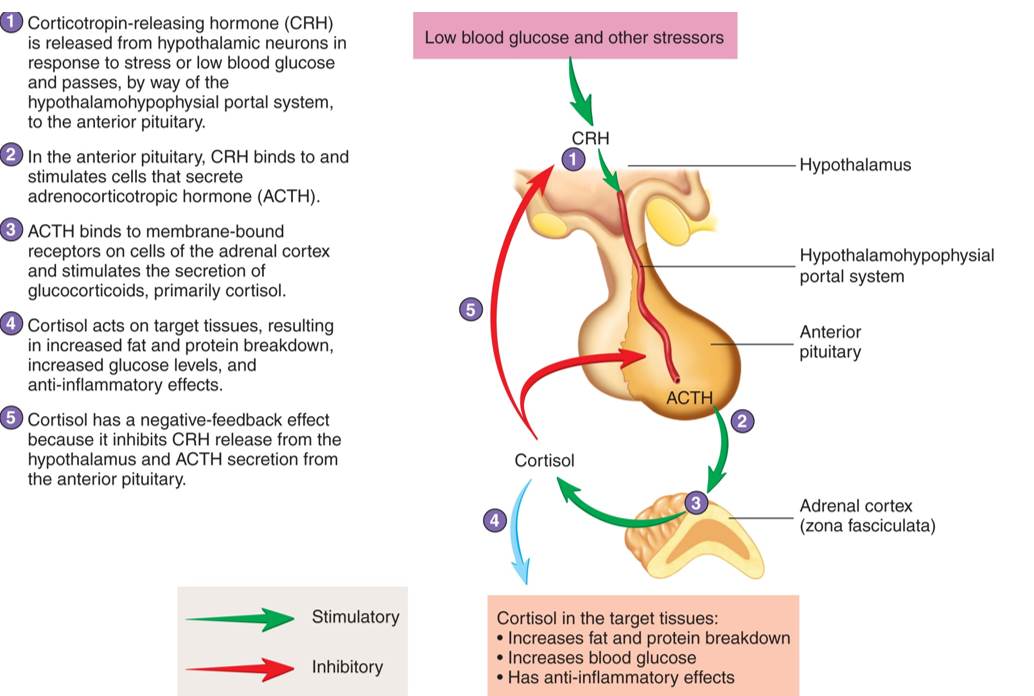
Androgens
Gland: adrenal cortex - zona reticularis
Type: steroid, lipid-soluble, nuclear receptor
Target tissues: many tissues
Effects: stimulate cell growth and differentiation in target tissues, produce gender-related differences in skeleton and secondary sexual characteristics
Stimulus: hormonal. ACTH
Regulation: negative feedback by downstream sex hormones
Epinephrine & norepinephrine
Gland: adrenal medulla
Type: amine, water-soluble, membrane receptor
Target tissues: heart, adipose, skeletal muscle, liver, blood vessels
Effects: increases blood glucose, increase fat breakdown, increase blood flow to heart and skeletal muscle, decrease blood flow to skin, urinary and digestive systems, increase blood pressure
Stimulus: neuronal (sympathetic nervous system). physical activity, low blood glucose
Regulation: short-term termination when stimulus removed
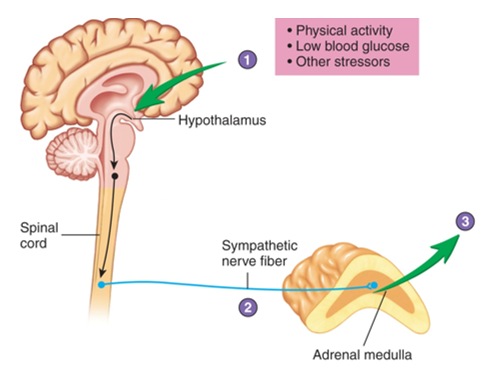
Insulin
Gland: pancreatic β cells
Type: peptide, water-soluble, membrane receptor
Target tissues: most cells
Effects: lowers blood glucose (increasing glucose uptake), increase lipid and glycogen storage
Stimulus: humoral. high blood glucose
Regulation: negative feedback when blood glucose normalizes
Glucagon
Gland: pancreatic α cells
Type: peptide, water-soluble, membrane receptor
Target tissues: liver, adipose, skeletal muscle
Effects: increase lipid metabolism, increase blood glucose
gluconeogenesis (glucose synthesis)
glycogen breakdown
Stimulus: humoral. low blood glucose
Regulation: negative feedback when blood glucose normalizes
List the steps of thyroid hormone synthesis
Iodide ions enter the follicle cell from the blood. This is controlled by a TSH-sensitive ion pump
Thyroid peroxidase oxidizes iodide (I-) into iodine (I0)
Iodine and thyroglobin enter colloid and iodine is bonded to tyrosines on thryoglobin
Thyroglobin is endocytosed from colloid
Thyroglobin is broken down in the lysosome. Other free amino acids are recycled
Released thyroid hormones (T3 and T4) diffuse across membrane into blood
Thyroid hormones bind to transport proteins
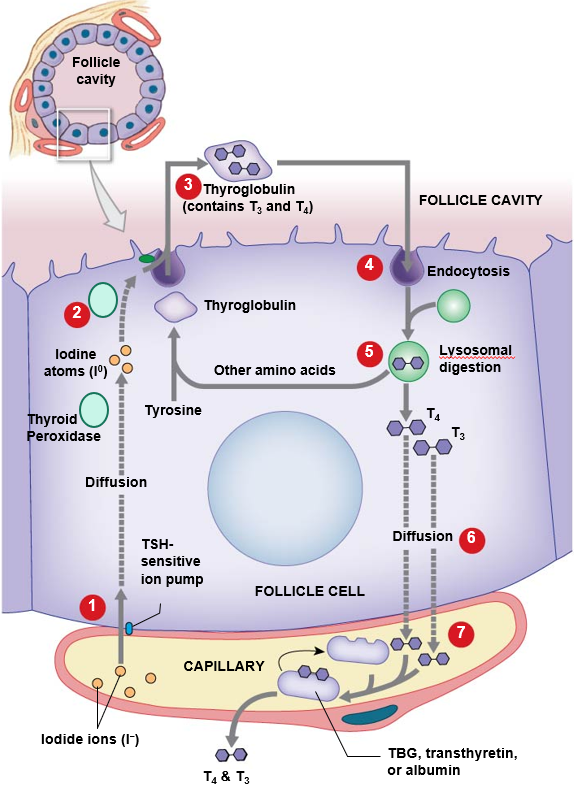
Explain the importance of the hypothalamus/pituitary axis in regulating hormone homeostasis
Hypothalamus is the master control: regulates endocrine and neural activities. Regulates secretions of anterior and posterior pituitary gland, which release hormones that influence other endocrine glands and target tissues. Controls hormone homeostasis via releasing/inhibiting hormones
Ex:
stress response (HPA axis)
TRH → TSH → thyroid hormone → negative feedback
What are the three types of endocrine reflexes?
Simple endocrine reflex, complex endocrine reflex, neuroendocrine reflexes
Describe endocrine reflex
Involves only one hormone
Controls hormone secretion by the heart, pancreas, parathyroid gland, and digestive tract
Ex: ADH, insulin
Describe complex endocrine reflex
One or more intermediary steps
Two or more hormones
Ex: TRH → TSH → TH
Describe neuroendocrine reflexes
Pathways include both neural and endocrine components
Ex: sympathetic control of adrenal medulla
Name the three ways two hormones may interact to influence physiological responses
Antagonistic effects, synergistic effects, permissive effects, integrative
Describe antagonistic effects
Opposing hormones
Ex: (calcitonin, PTH) (hyperglycemic vs. hypoglycemic)
Describe synergistic effects
Additive
Ex: hyperglycemic, GH, epinephrine, cortisol
Describe permissive effects
One hormone is necessary for another to produce effect
Ex: estrogen up-regulates progesterone receptor in uterine lining. Progesterone comes later in cycle and promotes uterine growth and nourishment (glycogen storage)
Describe integrative
Hormones produce different, but complementary results
Describe the general stress response (general adaptation syndrome)
Stress response, how body responds to stress causing factors
Divided into three phases
Alarm phase (initial stress producer)
Resistance phase (maintain homeostasis)
Exhaustion phase (homeostasis broken down)
Describe the alarm phase
Fight or flight; immediate
Sympathetic division of ANS system directs this response
Energy reserves are mobilized, mainly in the form of glucose
Body prepares to deal with the stress-causing factor by “fight or flight” responses (increase energy used)
Dominant hormone: epinephrine
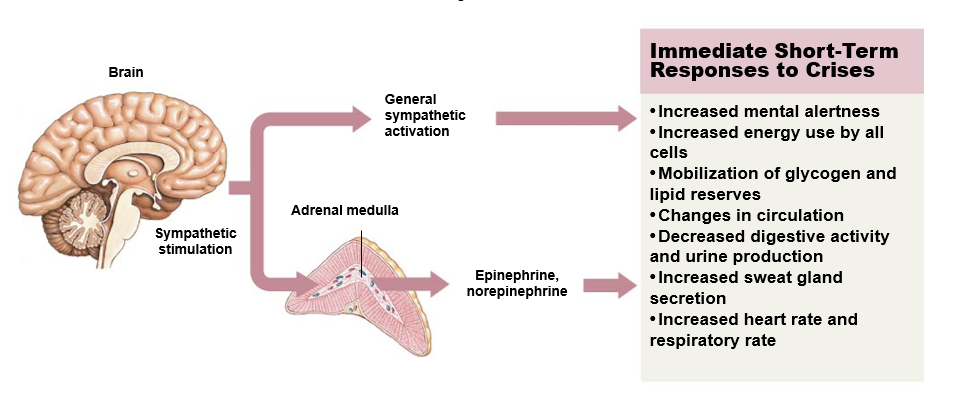
Describe the resistance phase
If a stress > few hours
Maintain for weeks - months
Dominant hormone: glucocorticoids (cortisol)
Epinephrine, GH, and thyroid hormones
Energy demands remain higher than normal
Neural tissue has a high demand for energy and requires a reliable supply of glucose
Hormones mobilize lipids and amino acids as energy sources to conserve glucose for use by neural tissue
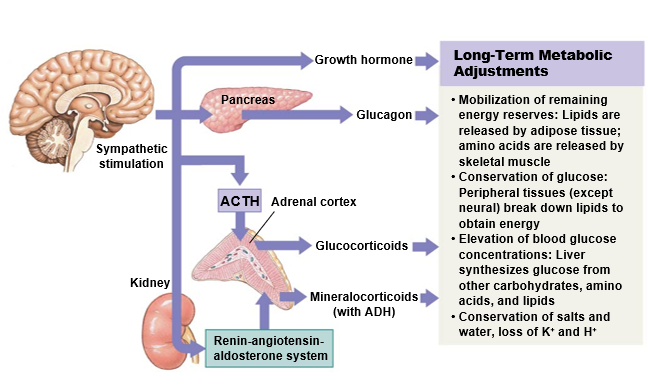
Describe the exhaustion phase
Homeostatic regulation breaks down
Unless corrective actions are taken immediately, the failure of one or more organ systems will provide fatal (too much K+ is used)
Chronic high aldosterone levels cause in a conservation of Na+ at the expensive of K+
As the body’s K+ content decreases, a variety of cells begin to malfunction
Underlying problem is the body’s inability to sustain the endocrine and metabolic adjustments of the resistance phase
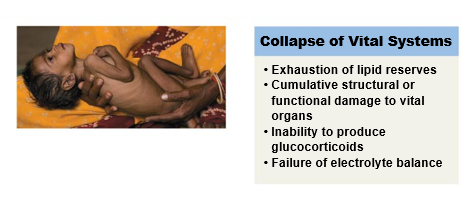
Show the control of blood nutrients during short-term exercise (<1 hour)
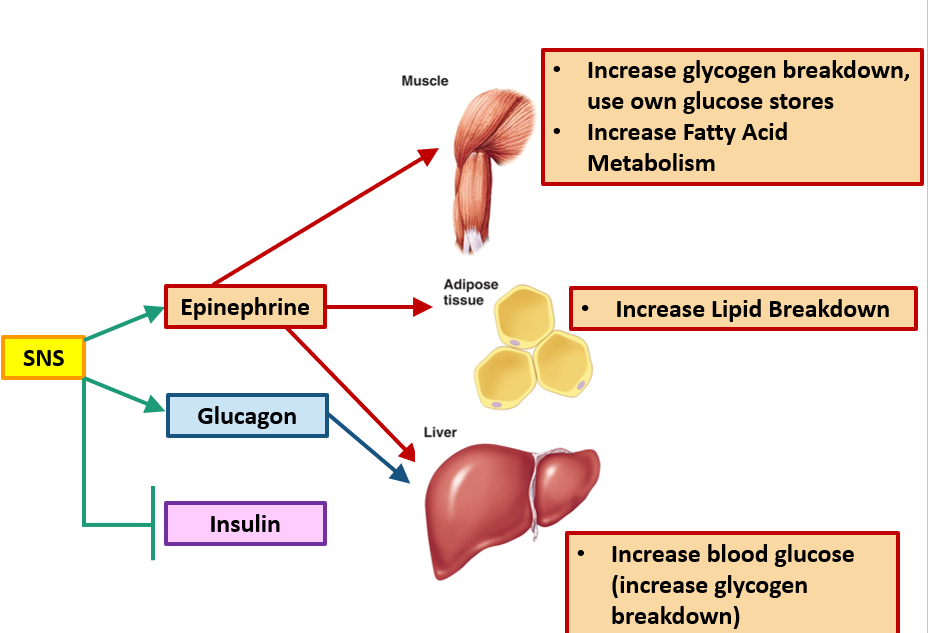
Show the control of blood nutrients during long-term exercise (>1 hour)
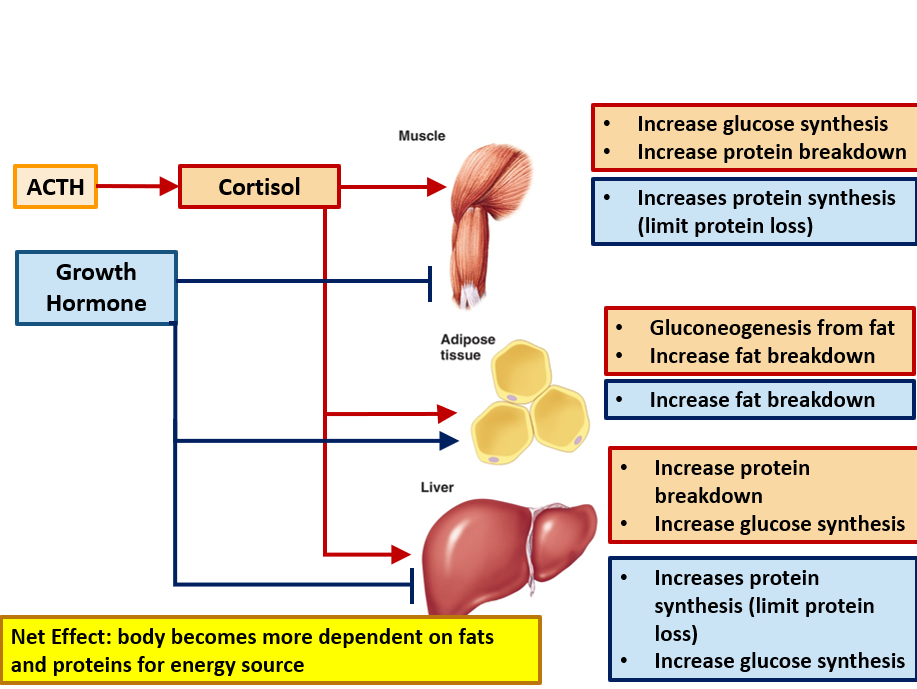
Diabetes insipidus
Disfunction: insufficient response to/secretion of ADH
Rare
Kidneys pass an abnormally large volume of fluid that is insipid (odorless, colorless)
Cause:
Central DI - ADH (vasopressin) not produced by posterior pituitary
Nephrogenic DI - kidneys do not respond to ADH (vasopressin)
Symptoms:
Constant thirst
Frequent urination
Normal blood glucose
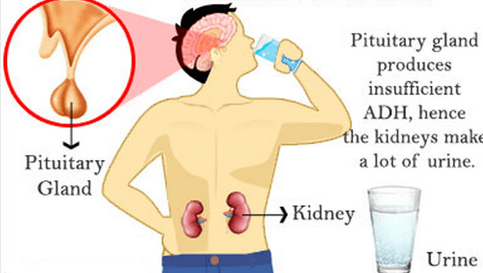
Acromegaly
Disfunction: excessive GH
Cause: anterior pituitary tumor produces excess GH
Symptoms:
hands and feet larger and swollen
bone changes: brow and lower jaw jut out, bridge of nose bigger, space between teeth increases
skin becomes thick, coarse, oily
sweating and skin odor incrase
voice deeper
joint aches
vision problems
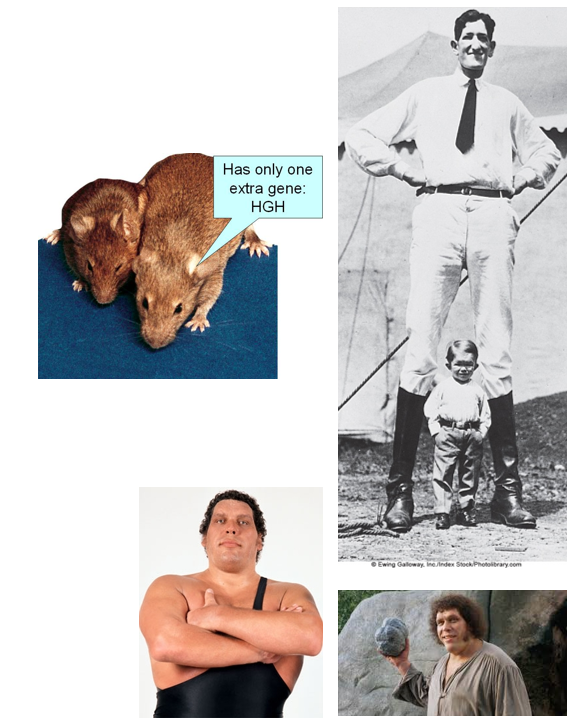
Hyperthyroidism
Excessive TH
Grave’s disease: autoimmune disease caused antibody that mimics TSH, leading to overproduction of TH (most common)
Anterior pituitary adenoma (tumor): secerets excess TSH (rare)
Thyroid tumor/cancer: secretes excess TSH (rare)
Symptoms:
increased metabolic rate, high body temp
weight loss, increased appetite
weak skeletal muscles with tremors
diarrhea
protruding eyes (exophthalmos)
hyperactivity, insomnia
almost always a goiter
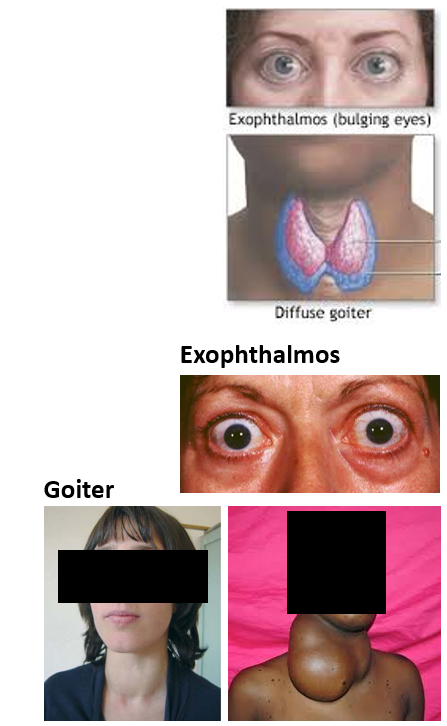
Hypothyroidism
Underproduction of thyroid hormone
Hashimoto’s thyroiditis: autoimmune disease caused by antibody that leads to destruction of thyroid gland (most common)
Iodine-deficiency: underproduction of thyroid hormone due to insufficient iodine intake
Symptoms:
decreased metabolic rate, low body temp
weight gain, reduced appetite
constipation
weak, untoned skeletal muscles
swelling of the face and body (myxedema)
possible goiter (enlargement of the thyroid gland)
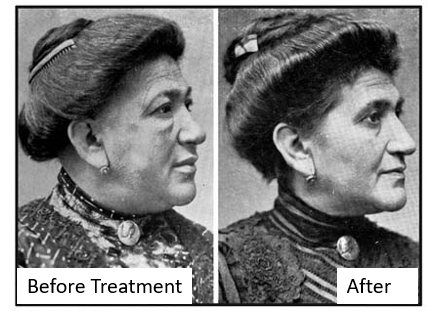
Adrenal insufficiency
Disfunction: adrenal glands fail to secrete enough cortisol and/or aldosterone
Primary: doesn’t produce aldosterone/cortisol
Addison’s disease: autoimmune disease destroys adrenal cortex outside to in, most common)
Secondary: impairment of anterior pituitary (decreased ACTH) (elsewhere)
Tertiary: impairment of the hypothalamus
Symptoms:
low blood levels of sodium and potassium
low blood pressure
depressed immune system
loss of appetite, nausea, vomiting
bronzing of skin due to increased pigmentation
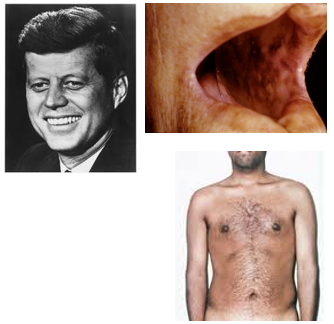
Cushing disease/syndrome
Disfunction: excessive amounts of cortisol and/or aldosterone
Syndrome: general characteristics of excessive cortisol/aldosterone
Exogenous: prolonged use of corticosteroid-like medication (prednisone)
Disease: anterior pituitary tumor causing excessive ACTH production
Symptoms:
high blood glucose levels, leads to diabetes mellitus
depressed immune system
muscle atrophy and weakness, osteoporosis
euphoria and depression
face looks swollen and puffy
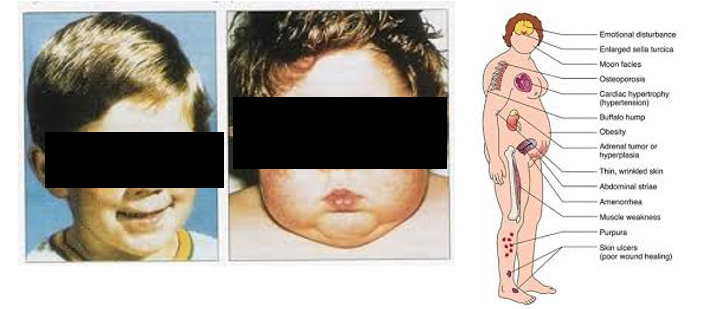
Diabetes mellitus
Type 1 - 10% of cases - “juvenile”
Autoimmune disorder - antibodies produced that destroys β cells
Insulin dependent - injections are required
Symptoms:
increased thirst and hunger, frequent urination, yeast infections, headache, unexplained weight loss, fatigue and weakness
Type 2 - 90% of cases - “Adult”
Reduced ability of tissues to respond to insulin
Non-insulin dependent
Non-pharmaceutical treatments include diet, exercise, & weight loss
Symptoms: excessive thirst and hunger, frequent urination, unexplained weight loss, fatigue, genital yeast, headaches
